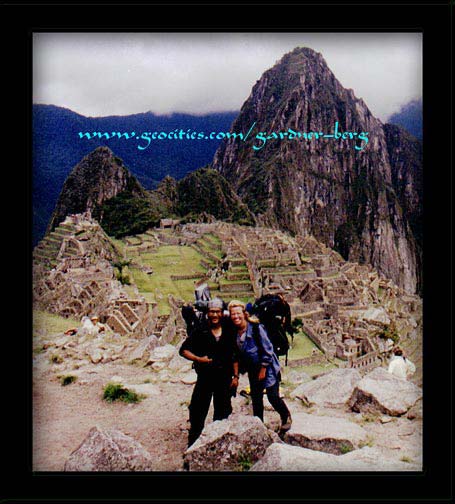
Machu Picchu, PERU
| Translate: EspaŮol - FranÁais - Deutsch - Italiano - PortuguÍs - Japanese - Korean - Chinese |

Machu Picchu, PERU
| Translate: EspaŮol - FranÁais - Deutsch - Italiano - PortuguÍs - Japanese - Korean - Chinese |

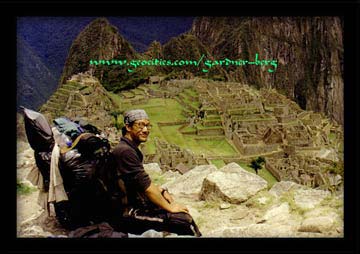 NOVEMBER 18, 2000 -- On our way out of the village, our national park entry passes are checked, then stamped. A nice, easy leg of the journey, except for steep stairways up to Intipunku (the Sun Gate) - so steep we had to climb them. We reached the top expecting to see the magnificent Machu Picchu below. But it was covered in mist instead. We didn't wait long until the fog subsided and there before us was a site seen in so many travel magazines, books, videos, posters, and postcards. For us first-time trekkers, it's the way any first trek should end.
NOVEMBER 18, 2000 -- On our way out of the village, our national park entry passes are checked, then stamped. A nice, easy leg of the journey, except for steep stairways up to Intipunku (the Sun Gate) - so steep we had to climb them. We reached the top expecting to see the magnificent Machu Picchu below. But it was covered in mist instead. We didn't wait long until the fog subsided and there before us was a site seen in so many travel magazines, books, videos, posters, and postcards. For us first-time trekkers, it's the way any first trek should end.
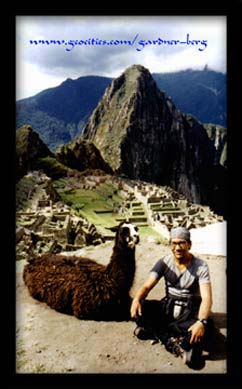
More than 500 years before Christ, the culture of Chavin emerged in the central Andes and extended its influence as far as the coast. Then, from the 10th century onward, both Tiwanaku on the shores of Lake Titicaca, and Huari, in the Ayacucho region, underwent considerable expansion. On the northern coast, around the 7th century, the Mochica developed an original culture as evidenced by their lifelike ceramics. In the south, the Paracas culture produced America's finest woven textiles used to cover their dead. In more recent times, scattered tribes along the northern coast had united to form the Chimu kingdom, based at Chan Chan.

The Incan Empire grew from a small undistinguished tribal group that arose around 1200 AD. After defeating the neighbouring Chancas in 1438, an Inca
leader, Pachacuti, declared himself emperor. Between 1440 and 1475, the Incas united the central Andes through force, putting an end to independent regional cultures. Inca grandeur had for its foundations more than 4000 years of Andean
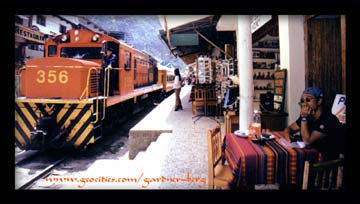 cultural traditions. What distinguished the Incas from their prior societies was the scope of their ambition, a more effective administration of their social structure, and the ability to enforce their will through battle. It's
society was based on 'mita' - taxation in the form of labour - and on a 3-way division of land. The fruits and products of one part were dedicated to the gods and the clergy; those of the second part went directly to the common people. The religion of the Inca was originally developed by classical Tiwanaku culture, primarily the worship of the Sun.
cultural traditions. What distinguished the Incas from their prior societies was the scope of their ambition, a more effective administration of their social structure, and the ability to enforce their will through battle. It's
society was based on 'mita' - taxation in the form of labour - and on a 3-way division of land. The fruits and products of one part were dedicated to the gods and the clergy; those of the second part went directly to the common people. The religion of the Inca was originally developed by classical Tiwanaku culture, primarily the worship of the Sun.
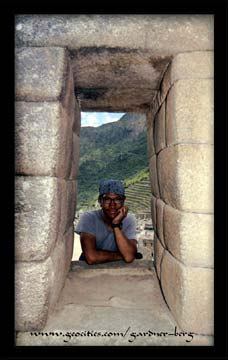
Excited, we scramble down as if we'd found a McDonalds restaurant in the middle of the Sahara Desert. We pass many smiling people here on day tours from Cuzco in familiar white T-shirts, hats, shades and video cameras heading up to the Sun Gate. Apparently, backpacks are prohibited on the premises; they have to be checked in at the ticket office. Once the packs are secured, we sign the register having completed the trail from Km 88, then we zero in towards the kiosk to order a burger each with everything on it. Overpriced but who cares.
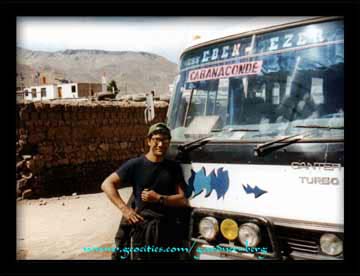 The rest of the morning and early afternoon was spent touring the ruins. We bumped into some trekkers we'd met during the trail, ready to catch the return train to Cuzco. Staying at the town of Aguas Calientes for a few days to clean up our gear and ourselves was a wise move, because our 2 friends from USA showed as we were wandering around the streets looking for cheap accomodation.
The rest of the morning and early afternoon was spent touring the ruins. We bumped into some trekkers we'd met during the trail, ready to catch the return train to Cuzco. Staying at the town of Aguas Calientes for a few days to clean up our gear and ourselves was a wise move, because our 2 friends from USA showed as we were wandering around the streets looking for cheap accomodation.
NOVEMBER 21, 2000 -- An afternoon train back to Cuzco (5 hours). Dinner the following night bidding farewell to our friends on their return to the states. Lucky them.
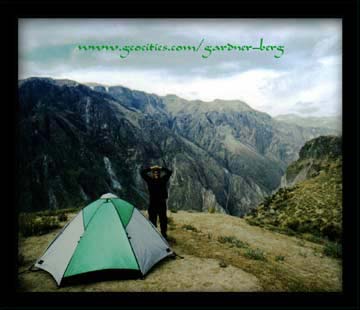
NOVEMBER 23, 2000 -- We leave Cuzco on a bus heading directly south across rough dry highland terrain. After about 8 and a half hours we get a signal from the driver that our stop is approaching. We get dropped off by a bridge junction where a small dirt road veers off the main road to Arequipa. The cold wind was blowing dust around where we stood. There were a few locals standing by an empty combi van on the other side of the road. So we drag our packs over there and ask if they were heading to Chivay.
Chivay (3600 m.a.s.l.) is the main gateway town into the Colca Canyon, twice the depth of the Grand Canyon in Arizona State, USA, but in our opinion, not as spectacular.
The next morning we catch a bus to Mirador Cruz del Condor where we get off and look around for a place to camp. We opt for a place near the edge of a sheer drop over the Colca River far below. It was nice, quiet and, according to the National Park officials that visited our tent the next morning, illegal. We didn't put up a fuss knowing they can get very emotional if provoked in the slightest, and armed police are present in the area escorting tour groups from Arequipa.
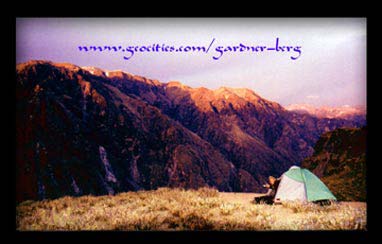
Oh well, at least we saw 3 Condors.
We flag down a local bus back to Chivay and being so full we got to ride on top and almost getting in trouble before a police checkpoint. We found out that the same bus was going to Arequipa that same afternoon, so to save on accomodation we wait on board at Chivay. 4.30pm we arrive in the white city of Arequipa. A pleasant city full of friendly people, but we don't stay long. We resupply, repack, and check out of Peru on a night bus to Bolivia a couple of days later.
Photos and Text Copyright © 1999-2001 Gardner-Berg. All rights reserved.
Sources of Further Reading-
Bingham, Hiram. "The Lost City of the Incas: The Story of Macchu Pichu and its Builders", 1951.
Cameron, Ian. The Kingdom of the Sun God: A History of the Andes and its People, 1990.
Garcilaso de la Vega, Inca. "The Royal Commentaries of the Incas and General History of Peru" 1869, 1871 and (original 1609).
Kendall, Ann. "The Everyday Life of the Inca" 1989.
Mosley, Michael E. "The Incas and their Ancestors: The Archaelogy of Peru" 1992.
Rostworowski De Diez Canseco, Maria. "History of the Inca Realm" 1998

